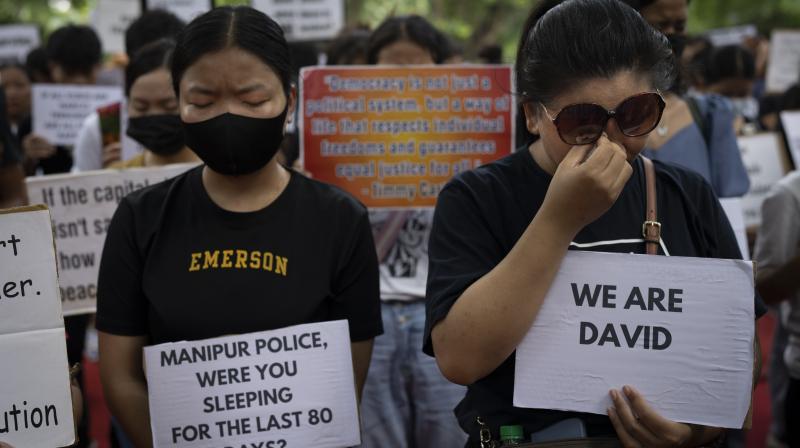
After some uneasy quiet over the past few months, India’s strategic border state of Manipur in the Northeast is on the boil again, with intelligence reports indicating that hundreds of Kuki-Zo tribals from Myanmar are waiting to infiltrate. While these reports have been officially denied, it is beyond doubt that all Northeast states are connected with Myanmar, Bangladesh, Bhutan and Nepal and impact each other in multiple ways.
The turmoil in neighbouring Myanmar that borders on civil war had earlier prompted the Centre to decide the India-Myanmar border will be covered by barbed fencing on the same lines as the India-Bangladesh border. The states of Arunachal Pradesh, Nagaland, Manipur and Mizoram share a 1,643-km border with Myanmar.
Importantly, India has also abrogated the “free movement” agreement with Myanmar which allowed people living 16 km on each side of the border unfettered movement across the border on production of border passes. The ongoing violence in Myanmar raised deep security concerns in India, apart from the large influx of refugees expected to result, which will be a natural outcome of this turmoil.
India’s Northeast region, described in the government’s vision document 2020 as “rainbow country”, is surrounded by Bangladesh, Bhutan, China, Nepal and Myanmar. It includes the “seven sisters”: Arunachal Pradesh, Assam, Manipur, Meghalaya, Mizoram, Nagaland and Tripura. Sikkim too is seen as part of this region. The region has wide disparity in cultures
and a host of historical, political and social conflicts have afflicted this region for years, posing both external and internal security challenges to the country.
Northeast India has been in some form of turmoil or the other since India’s Independence in 1947, at times due to adverse external influences, internal fratricidal tribal conflicts or tussles with the Centre on many aspects, including sovereignty issues. Yet, over the years, there has been an unmistakable improvement, with tribals in various states joining the national mainstream and contributing to the nation’s growth. Though a majority of the tribals are now enthusiastic votaries of the country’s democratic system, yet some serious intra-tribal conflicts persist, sometimes leading to violence and mayhem.
Some of these are engineered from across the porous borders between the Northeast states and countries surrounding them, with China having a hidden hand in supporting some of these insurgencies.
The tumultuous and continuing violent situation in Manipur since the past one year or so, owing to a variety of reasons, symbolises the internecine tribal fissures existing which need to be addressed by the Centre with alacrity and sensitivity. That the civil war raging in neighbouring Myanmar for the past three years has also contributed to instability in Manipur and threatens to spread to Mizoram and even other northeastern states is a stark possibility. India’s Northeast region is the gateway for the successful pursuit of India’s “Look East” policy, now referred to as the “Act East” policy, which is a cardinal imperative for the nation. Thus, the significance of peace and political stability in Myanmar impacting India’s overall East Asian strategy is non-negotiable. The unexpected regime and ideology change in neighbouring Bangladesh with the expulsion of pro-India PM Sheikh Hasina from the country has further added to likely security problems for India.
In the past three years or so, apart from causing unnecessary casualties to peace-loving civilians and the total disruption in human rights among its citizenry, Myanmar’s military junta has displayed its incompetence in ruling the nation. In the last three years, tens of thousands of people have fled their homes in Myanmar and sought refuge in India’s northeastern states, further compounding the security situation and augmenting tribal fissures in them.
Ironically, although itself a strong democracy, India always maintained a close relationship with Myanmar’s military, which carries a reputation of undermining democracy in Myanmar and being authoritarian in all respects. New Delhi feels the military junta’s cooperation is essential for India to deal with the many insurgent outfits roaming around within and outside the Northeast. Myanmar’s help in counter-insurgency operations by striking cross-border against Chinese proxy gangs, who are based in Myanmar’s inhospitable border regions, is sought by the Indian security forces and thus India strives to maintain sound relations with the junta.
For India, the international pulls and pressures within Myanmar, the inability of the junta to maintain peace and order inside their nation and the proliferation of strong insurgent and separatist groups portends ominous tidings. The influx of illegal immigrants, increase in the already existing substantial drugs trade and weapons to fuel local insurgent groups within our Northeast region, is fraught with serious security concerns. The prevailing situation in Manipur state is a manifestation of this ascending malady.
Apart from a rise in tribals demanding economic dominance in certain regions of the Northeast, there exists among some of them separatist tendencies which need to be closely monitored and nipped in the bud.
Despite any other preoccupations, India’s security establishment must devote adequate time to holistically evolve a comprehensive and firm policy to ensure the maintenance of peace and stability in the strategic Northeast region.
On efforts to usher in peace in violence-hit Manipur, there is no better alternative than the imposition of President’s Rule there and giving the Army a free hand to control the situation inside Manipur and prevent infiltration from Myanmar into Manipur. The militant groups will have to be disarmed. Importantly, various tribes will have to be made to sit together and evolve a commonly accepted solution. It is high time that the Government of India recasts its overall priorities and takes a holistic and determined view at the highest levels to bring back normalcy to Manipur for it gravely impacts the entire security paradigm of our Northeast region.
